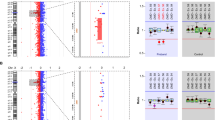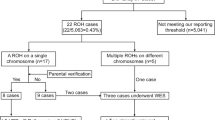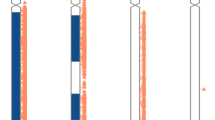Abstract
Chromosome mosaicism is detected in about 1–2% of chorionic villi samples (CVS), and may be due to a postzygotic nondisjunction event generating a trisomic cell line in an initially normal conceptus (mitotic origin) or the postzygotic loss of one chromosome in an initially trisomic conceptus (meiotic origin and trisomy rescue). Depending on the distribution of the abnormal cell line, the mosaic can be confined to the placenta (CPM) or generalised to the fetus (TFM, true fetal mosaicism). Trisomy rescue could theoretically be associated with a 33.3% probability of uniparental disomy (UPD) in the fetus. The aim of this study was to determine the risk of fetal involvement in a cohort of numerical and structural chromosome mosaics revealed in chorionic villi by means of combined direct and long-term culture analyses; we also determined the incidence of UPD associated with mosaic aneuploidies and supernumerary markers involving imprinted chromosomes. A total of 273 of a consecutive series of 15 109 CVS evaluated during a period of 5 years showed a mosaic condition in direct preparations and/or long-term cultures; confirmatory amniocentesis was performed in 203 cases. The abnormal cell line was extended to the fetus in 12.8% cases in terms of structural and numerical abnormalities involving autosomes and sex chromosomes; the risk of TFM varied and depended on the placental tissue distribution of the abnormal cell line. One of the 51 cases in which the mosaic involved an imprinted chromosome showed UPD, thus indicating a risk of 1.96%.
Similar content being viewed by others
Log in or create a free account to read this content
Gain free access to this article, as well as selected content from this journal and more on nature.com
or
References
Vejerslev LO, Mikkelsen M : The European collaborative study on mosaicism in chorionic villus sampling: data from 1986 to 1987. Prenat Diagn 1989; 9: 575–588.
Medical Research Council working party on the evaluation of chorionic villus sampling: Medical Research Council European trial of chorionic villus sampling. Lancet 1991; 337: 1491–1499.
Teshima IE, Kalousek DK, Vekemans MJ et al: Canadian multicenter randomized clinical trial of chorion villus sampling and amniocentesis. chromosome mosaicism in CVS and amniocentesis samples. Prenat Diagn 1992; 12: 443–466.
Ledbetter DH, Zachary JM, Simpson JL et al: Cytogenetic results from the US Collaborative Study on CVS. Prenat Diagn 1992; 12: 317–345.
Smidt-Jensen S, Lind AM, Permin M, Zachary JM, Lundsteen C, Philip J : Cytogenetic analysis of 2928 CVS samples and 1075 amniocenteses from randomized studies. Prenat Diagn 1993; 13: 723–740.
Wang BB, Rubin CH, Williams 3rd J : Mosaicism in chorionic villus sampling: an analysis of incidence and chromosomes involved in 2612 consecutive cases. Prenat Diagn 1993; 13: 179–190.
Association of Clinical Cytogeneticists Working Party on Chorionic Villi in Prenatal Diagnosis: Cytogenetic analysis of chorionic villi for prenatal diagnosis: an ACC collaborative study of UK data. Prenatal Diagn 1994; 14: 363–379.
Wolstenholme J, Rooney DE, Davison EV : Confined placental mosaicism, IUGR, and adverse pregnancy outcome: a controlled retrospective UK collaborative survey. Prenat Diagn 1994; 14: 345–361.
Stetten G, Escallon CS, South ST, McMichael JL, Saul DO, Blakemore KJ : Reevaluating confined placental mosaicism. Am J Med Genet 2004; 131: 232–239.
Simoni G, Fraccaro M : Does confined placental mosaicism affect the fetus? Hum Reprod 1992; 7: 139–140.
Kalousek DK, Barrett IJ, Gartner AB : Spontaneous abortion and confined chromosomal mosaicism. Hum Genet 1992; 88: 642–646.
Simoni G, Sirchia SM : Confined placental mosaicism. Prenat Diagn 1994; 14: 1185–1189.
Robinson WP, Barrett IJ, Bernard L et al: Meiotic origin of trisomy in confined placental mosaicism is correlated with presence of fetal uniparental disomy, high levels of trisomy in trophoblasts, and increased risk of fetal intrauterine growth restriction. Am J Hum Genet 1997; 60: 917–927.
Engel E, DeLozier-Blanchet CD : Uniparental disomy, isodisomy, and imprinting: probable effects in man and strategies for their detection. Am J Med Genet 1991; 40: 432–439.
Kalousek DK : Pathogenesis of chromosomal mosaicism and its effect on early human development. Am J Med Genet 2000; 91: 39–45.
Spence JE, Perciaccante RG, Greig GM et al: Uniparental disomy as a mechanism for human genetic disease. Am J Hum Genet 1988; 42: 217–226.
Voss R, Ben-Simon E, Avital A et al: Isodisomy of chromosome 7 in a patient with cystic fibrosis: could uniparental disomy be common in humans? Am J Hum Genet 1989; 45: 373–380.
Kalousek DK, Langlois S, Barrett I et al: Uniparental disomy for chromosome 16 in humans. Am J Hum Genet 1993; 52: 8–16.
Kalousek DK, Barrett I : Genomic imprinting related to prenatal diagnosis. Prenat Diagn 1994; 14: 1191–1201.
Ledbetter DH, Engel E : Uniparental disomy in humans: development of an imprinting map and its implications for prenatal diagnosis. Hum Mol Genet 1995; 4: Spec No 1757–1764.
Eggermann T, Zerres K, Eggermann K, Moore G, Wollmann HA : Uniparental disomy: clinical indications for testing in growth retardation. Eur J Pediatr 2002; 161: 305–312.
Grati FR, Sirchia SM, Garagiola I et al: Losses of heterozygosity in oral and oropharyngeal epithelial carcinomas. Cancer Genet Cytogenet 2000; 118: 57–61.
Hahnemann JM, Vejerslev LO : European collaborative research on mosaicism in CVS (EUCROMIC) – fetal and extrafetal cell lineages in 192 gestations with CVS mosaicism involving single autosomal trisomy. Am J Med Genet 1997; 70: 179–187.
Daniel A, Wu Z, Darmanian A et al: Issues arising from the prenatal diagnosis of some rare trisomy mosaics – the importance of cryptic fetal mosaicism. Prenat Diagn 2004; 24: 524–536.
Smith K, Lowther G, Maher E, Hourihan T, Wilkinson T, Wolstenholme J : The predictive value of findings of the common aneuploidies, trisomies 13, 18 and 21, and numerical sex chromosome abnormalities at CVS: experience from the ACC UK Collaborative Study. Association of Clinical Cytogeneticists Prenatal Diagnosis Working Party. Prenat Diagn 1999; 19: 817–826.
Miny P, Hammer P, Gerlach B et al: Mosaicism and accuracy of prenatal cytogenetic diagnoses after chorionic villus sampling and placental biopsies. Prenat Diagn 1991; 11: 581–589.
Wolstenholme J : An audit of trisomy 16 in man. Prenat Diagn 1995; 15: 109–121.
Wolstenholme J : Confined placental mosaicism for trisomies 2, 3, 7, 8, 9, 16, and 22: their incidence, likely origins, and mechanisms for cell lineage compartmentalization. Prenat Diagn 1996; 16: 511–524.
Sirchia SM, De Andreis C, Pariani S et al: Chromosome 14 maternal uniparental disomy in the euploid cell line of a fetus with mosaic 46,XX/47,XX,+14 karyotype. Hum Genet 1994; 94: 355–358.
Ralph A, Scott F, Tiernan C et al: Maternal uniparental isodisomy for chromosome 14 detected prenatally. Prenat Diagn 1999; 19: 681–684.
Fokstuen S, Ginsburg C, Zachmann M, Schinzel A : Maternal uniparental disomy 14 as a cause of intrauterine growth retardation and early onset of puberty. J Pediatr 1999; 134: 689–695.
Sanlaville D, Aubry MC, Dumez Y et al: Maternal uniparental heterodisomy of chromosome 14: chromosomal mechanism and clinical follow up. J Med Genet 2000; 37: 525–528.
Towner DR, Shaffer LG, Yang SP, Walgenbach DD : Confined placental mosaicism for trisomy 14 and maternal uniparental disomy in association with elevated second trimester maternal serum human chorionic gonadotrophin and third trimester fetal growth restriction. Prenat Diagn 2001; 21: 395–398.
Aretz S, Raff R, Woelfle J, Zerres K, Esser M, Propping P et al: Maternal uniparental disomy 14 in a 15-year-old boy with normal karyotype and no evidence of precocious puberty. Am J Med Genet A 2005; 135: 336–338.
Cox H, Bullman H, Temple IK : Maternal UPD(14) in the patient with a normal karyotype: clinical report and a systematic search for cases in samples sent for testing for Prader-Willi syndrome. Am J Med Genet A 2004; 127: 21–25.
Hordijk R, Wierenga H, Scheffer H, Leegte B, Hofstra RM, Stolte-Dijkstra I : Maternal uniparental disomy for chromosome 14 in a boy with a normal karyotype. J Med Genet 1999; 36: 782–785.
Author information
Authors and Affiliations
Corresponding author
Rights and permissions
About this article
Cite this article
Grati, F., Grimi, B., Frascoli, G. et al. Confirmation of mosaicism and uniparental disomy in amniocytes, after detection of mosaic chromosome abnormalities in chorionic villi. Eur J Hum Genet 14, 282–288 (2006). https://doi.org/10.1038/sj.ejhg.5201564
Received:
Revised:
Accepted:
Published:
Issue date:
DOI: https://doi.org/10.1038/sj.ejhg.5201564
Keywords
This article is cited by
-
Characteristics and mechanisms of mosaicism in prenatal diagnosis cases by application of SNP array
Molecular Cytogenetics (2023)
-
Prenatal diagnosis of mosaic chromosomal aneuploidy and uniparental disomy and clinical outcomes evaluation of four fetuses
Molecular Cytogenetics (2023)
-
Evidence-based clinical prioritization of embryos with mosaic results: a systematic review and meta-analysis
Journal of Assisted Reproduction and Genetics (2021)
-
Prenatal diagnosis of mosaic trisomy 2 and literature review
Molecular Cytogenetics (2020)
-
The accuracy of chromosomal microarray testing for identification of embryonic mosaicism in human blastocysts
Molecular Cytogenetics (2014)



